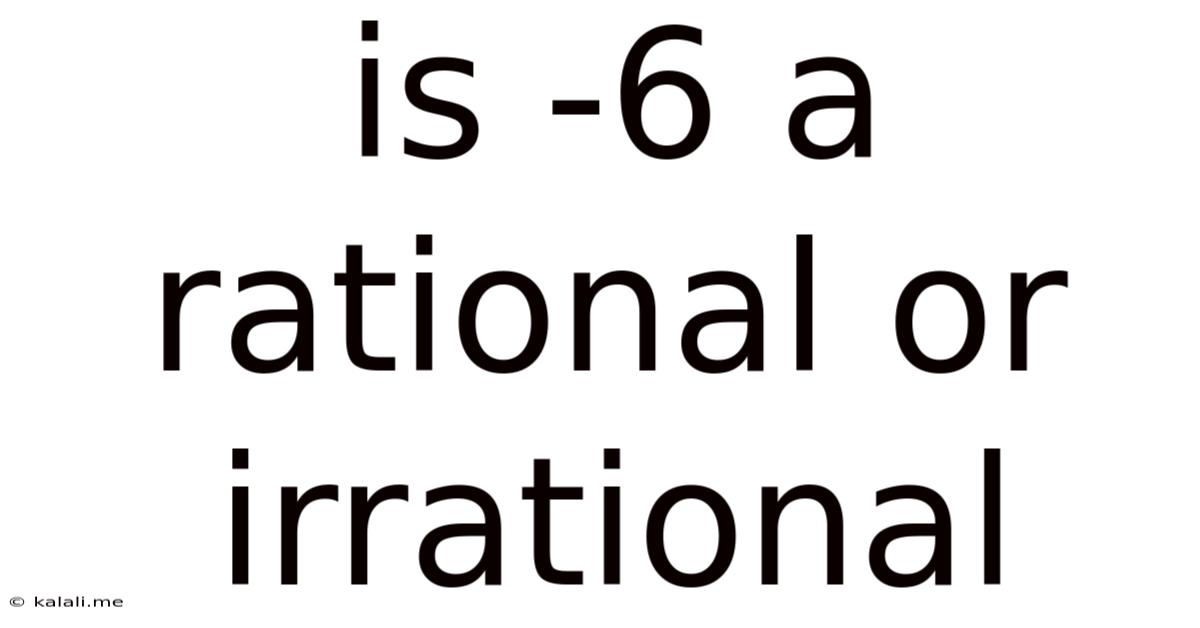Is -6 A Rational Or Irrational
Kalali
Mar 08, 2025 · 4 min read

Table of Contents
Is -6 a Rational or Irrational Number? A Comprehensive Guide
The question of whether -6 is rational or irrational might seem trivial at first glance. However, understanding the fundamental difference between rational and irrational numbers is crucial for a solid grasp of mathematics. This comprehensive guide will delve into the definition of rational and irrational numbers, explore the properties of -6, and definitively answer the question, providing a clear and concise explanation suitable for students and anyone interested in strengthening their mathematical foundation.
Understanding Rational Numbers
A rational number is any number that can be expressed as a fraction p/q, where 'p' and 'q' are integers, and 'q' is not equal to zero. This seemingly simple definition has profound implications. Let's break it down:
- Integers: Integers include all whole numbers (positive, negative, and zero). Examples: -3, 0, 5, 100, -1000.
- Fraction: A fraction represents a part of a whole. It's a ratio of two numbers.
- q ≠ 0: The denominator (the bottom part of the fraction) cannot be zero because division by zero is undefined in mathematics.
Examples of rational numbers include:
- 1/2: One-half is a rational number because it's a fraction where both the numerator (1) and denominator (2) are integers.
- -3/4: Negative three-quarters is also rational. Both -3 and 4 are integers.
- 5: The whole number 5 can be expressed as a fraction: 5/1. Therefore, it's rational.
- 0: Zero can be expressed as 0/1, making it a rational number.
- 0.75: This decimal can be expressed as the fraction 3/4, thus it's rational.
- -2.5: This can be expressed as -5/2, making it rational.
Understanding Irrational Numbers
Irrational numbers, on the other hand, cannot be expressed as a fraction of two integers. Their decimal representation is non-terminating (it never ends) and non-repeating (the digits don't follow a predictable pattern).
Famous examples of irrational numbers include:
- π (Pi): The ratio of a circle's circumference to its diameter. Its decimal representation goes on forever without repeating.
- √2 (Square root of 2): This is the number that, when multiplied by itself, equals 2. It cannot be expressed as a simple fraction.
- e (Euler's number): The base of the natural logarithm. Like π, its decimal representation is infinite and non-repeating.
- √7: The square root of 7 is another example of an irrational number.
Analyzing -6
Now, let's analyze the number -6. Can it be expressed as a fraction p/q where p and q are integers and q ≠ 0?
The answer is a resounding yes. We can express -6 as:
- -6/1
- -12/2
- -18/3
- and so on...
In each case, both the numerator and denominator are integers, and the denominator is not zero. Therefore, -6 perfectly fits the definition of a rational number.
The Significance of the Definition
The distinction between rational and irrational numbers is fundamental to many areas of mathematics. Understanding this difference is essential for:
- Algebra: Solving equations and inequalities often requires working with both rational and irrational numbers.
- Calculus: Understanding limits and continuity relies heavily on the properties of rational and irrational numbers.
- Geometry: Calculations involving lengths, areas, and volumes often involve both rational and irrational numbers (like π).
- Number Theory: This branch of mathematics extensively studies the properties of rational and irrational numbers, including their distribution and relationships.
Further Exploring Rational and Irrational Numbers
Let's delve deeper into some related concepts:
Decimal Representation
Rational numbers always have either a terminating decimal representation (e.g., 0.25) or a repeating decimal representation (e.g., 0.333...). Irrational numbers, however, have non-terminating and non-repeating decimal representations. This provides a practical way to distinguish between them.
Density of Rational and Irrational Numbers
Both rational and irrational numbers are dense on the number line. This means that between any two distinct rational numbers, there exists another rational number, and similarly, between any two distinct irrational numbers, there exists another irrational number. This property highlights the richness and complexity of the real number system.
Real Numbers
Rational and irrational numbers together constitute the set of real numbers. Real numbers represent all points on the number line, encompassing both the precisely measurable (rational) and the infinitely precise (irrational).
Common Mistakes and Misconceptions
A common misconception is that any number with a decimal representation is irrational. This is incorrect. As shown earlier, rational numbers can also have decimal representations, albeit terminating or repeating ones.
Conclusion: -6 is Rational
In conclusion, -6 is unequivocally a rational number. It satisfies the definition of a rational number by being expressible as a fraction of two integers (-6/1, for example). Understanding the characteristics of rational and irrational numbers is paramount for a solid grasp of mathematical concepts. This guide aims to clarify the distinction and firmly establish the rational nature of -6. Remember that the ability to express a number as a fraction of two integers is the key determining factor in classifying it as rational. The inclusion of negative signs doesn’t alter this fundamental property. By understanding this core principle, you will strengthen your mathematical foundation and confidently address similar questions.
Latest Posts
Latest Posts
-
How Long Does It Take To Drive 2000 Miles
Jul 18, 2025
-
How Many Grams In A Teaspoon Of Cinnamon
Jul 18, 2025
-
How Long To Heat Water In Microwave
Jul 18, 2025
-
40 Oz Of Water Is How Many Cups
Jul 18, 2025
-
How Many Eighths In A Quarter Pound
Jul 18, 2025
Related Post
Thank you for visiting our website which covers about Is -6 A Rational Or Irrational . We hope the information provided has been useful to you. Feel free to contact us if you have any questions or need further assistance. See you next time and don't miss to bookmark.